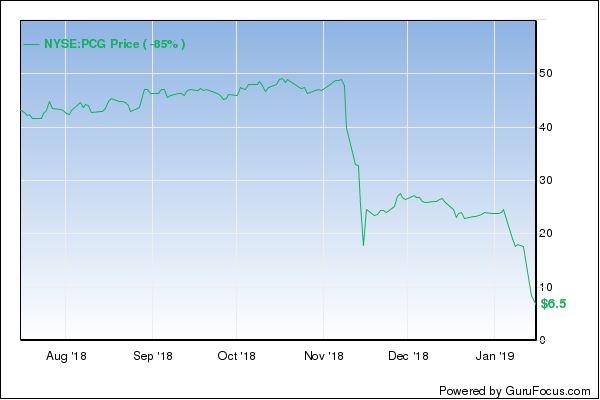Hedge Funds Battered by PG&E Trade
- By Rupert Hargreaves
PG&E Corp. (PCG) is rapidly evolving into a situation where some of Wall Street's biggest names have been caught off guard by developments outside of a company's control.
As I have covered before, several of the biggest hedge funds in the business, including Seth Klarman (Trades, Portfolio)'s Baupost, owned shares in Californian utility PG&E at the end of the third quarter. And I have noticed the company's name appearing in many different hedge fund letters since.
Warning! GuruFocus has detected 4 Warning Signs with PCG. Click here to check it out.
The intrinsic value of PCG
It seems the consensus was that shares in the utility had been oversold due to concerns about its liabilities stemming from the recent spate of California wildfires. Value-seeking hedge funds seemed to believe that state regulators would not allow the utility provider to collapse and that it had plenty of liquidity available to be able to meet any insurance claims.
On Monday, it emerged that PG&E's management has now decided that the best course of action for the company is to declare bankruptcy. As the Associated Press reported yesterday:
"The nation's largest utility said Monday it is filing for Chapter 11 bankruptcy because it faces at least $30 billion in potential damages from lawsuits over the catastrophic wildfires in California in 2017 and 2018 that killed scores of people and destroyed thousands of homes."
By taking this step, management should be able to hold off creditors and continue providing electricity and natural gas without interruption to its 16 million customers. In other words, the utility is buying time.
Buying time
As of yet, we don't know how this will work out for shareholders, although it is reasonable to assume at this stage that they will be wiped out. Some estimates suggest that the company had about $50 billion in liabilities at the end of 2017. That is excluding insurance claims from the 2018 wildfires. Before open on Tuesday, the company's market capitalization had slumped to $4.4 billion.
This is another interesting case study of how sometimes Wall Street's best and brightest get it wrong. According to recent hedge fund correspondence, funds have been buying the shares all the way down to $20 (not to mention debt, which some hedge funds have been buying as an alternative way to bet on the share price).
Even at this depressed level, the risk-reward ratio seemed tenuous. A quick back-of-the-envelope calculation shows that even before the bankruptcy filing was announced, PG&E's equity would only have been worth a fraction of its market capitalization in the worst-case scenario.
At the beginning of January, wildfire liabilities for 2018 were estimated around $15 billion, compared to total shareholder equity of $19.7 billion at the end of the third quarter of 2018, which leaves for investors a stub of equity of $4.7 billion, or around $9 per share.
That being said, it is often the case that initial insurance estimates overestimate the total volume of claims that are eventually paid out because insurance companies want to distribute as little as possible. So, it could be assumed that the initial $15 billion estimate was the worst-case scenario. However, even in this worst-case scenario, the stock did not look cheap at $20. Even after the stock fell 50% on Monday, there is still no margin of safety between the worst-case scenario and the current stock price.
Simple is best
This is a fascinating case study in estimating risk-reward probabilities. For the average investor, trying to calculate the exact volume of claims PG&E might have been facing would have been all but impossible.
We have only rough figures to go on. Detailed proprietary analysis conducted by multi-billion dollar hedge funds might have been more informative, but at the end of the day, these numbers still would have been just estimates.
Warren Buffett has often said that the best investments are simple and with PG&E, trying to calculate how much the equity might be worth in the worst-case scenario was never a simple project.
Rough figures provided some guidance, but even these indicated that the stock was overpriced above $9. There has also always been the risk that regulators may act to force the company's hand, and this is never a good risk for investors because it removes entirely any individual benefits or financial firepower the company might have.
If this analysis seems too simple, that is because it is supposed to be. Highly attractive value opportunities should be no-brainers. PG&E was a complicated situation from the start.
Disclosure: The author owns no share mentioned.
This article first appeared on GuruFocus.
Warning! GuruFocus has detected 4 Warning Signs with PCG. Click here to check it out.
The intrinsic value of PCG

